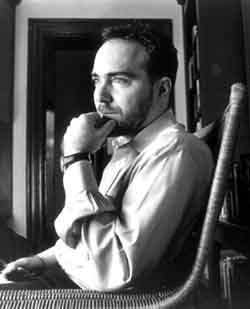Staff Q&A: The Writers House's Tom Devaney makes art while he sleeps. Thus, a book is born.
In my life I've taken practical measures to do impractical things.
The Penn Current
September 9, 2002

Position: Program Coordinator, Kelly Writers House Length
of service: 1 year Other
stuff: The 33-year-old spent the last six
years in New York, where he taught in the English department at Brooklyn College. He'll teach English 10 at Penn
this spring.
Photo by Candace diCarlo |
Not too long ago, Tom Devaney found himself in a boring job. And unlike most others who, in the same situation, would’ve trudged through with yawns and droopy eyes, the quiet-spoken Devaney made something out of nothing. He made art.
“Letters to Ernesto Neto,” due out this spring from Germ Monographs, is a collection of 28 letters Devaney wrote in 2001 while working as an art gallery guard, protecting an exhibit by Brazillian artist Ernesto Neto. The letters are a snapshot of Devaney’s active mind while working in a less than active job.
But life these days has picked up considerably for the Philadelphia native; he’s busy planning more than 150 programs per semester for the Kelly Writers House—the campus’s literary arts hub—and producing “Live at the Writers House,” a monthly spoken-word program that airs on WXPN (88.5 FM). He hopes this year’s calendar of events will stir up the same kind of excitement as last year’s schedule, which included such successes as the Poet & Painter Series and the Local Spotlight Series.
Even with all this activity, Devaney isn’t too busy for a chat with the Current.
Q. What is the inspiration for “Letters to Ernesto Neto”?
A. Right before I was hired I was in between jobs, and I was taking
a lot of different potshot jobs. I took a job guarding at this installation
by this Brazilian artist named Ernesto Neto, entitled “Only the Amoebas
Are Happy.” Basically my job was to watch this one piece for two
weeks, for six hours a day. So I started to get tired and sleepy and I
started writing letters. I’d write them—12:30, Dear Ernesto,
It’s allergy season. So I started to write the letters the second
week when I had already had a lot of interaction and experience with the
piece.
Q. So were visitors to the gallery more interested in what you were
writing?
A. Oh no, nobody would see me writing usually. I would just write
when people were in the piece. You had to get inside this amorphous bean
bag inside this room. Unlike most guards whose job it is to tell people
not to go near the art work, my job was to tell people to go into the
art work. I just had to make sure that nobody jumped too much in the bean
bag.
Q. Describe the piece of art.
A. It was this gigantic bean bag that came out into the gallery with
three arms. And you climbed on it. There was another amorphous, amoeba-like
bean bag inside and you just sat in there in dim blue lights and you just
experienced the piece. It was really fun.
Q. Does Neto know you wrote the book?
A. Yes, that was kind of the whole point. I wrote the letters and
we [Devaney and graphic artist Nicole Michels, the book’s designer]
sent him the book. He [Neto] loves it. Of course, I was just talking
about him all the time—
[Devaney flips open his book and reads a passage]
Ernesto,
A cell phone just went off inside the piece. Although the man is inside the installation, which is a natural acoustic damper, I hear him clearly answering (if I was closer I’d say shouting) to the first question all cell phone users ask each other, which is not how, but where are you? He says, ‘Laying down in an enclosed space on this huge biomorphic pillow.’ The person on the other end must say, ‘What? Where? Are you kidding?’ The man on the cell responded, ‘No, really—I’m not kidding.’
Yours again,
Tom
So I’m just writing different things that were happening. Sometimes I would be more reflective.
Q. How do the graphic elements of the book relate to your writing?
A. I feel that the presentation of the work is an important element
if it. And that it contributes to a more tangible object. These letters
become almost an object of art. I’m talking about somebody’s
art, but my art is writing. And the person who did the graphic design
also saw the project, saw the installation, and knows my writing very
well.
That kind of collaboration with someone who has a lot of sympathies and sensibilities can make something larger than yourself. My letters and her artwork together create something bigger for both of us. I think that element of collaboration, it brings you to places you wouldn’t necessarily go to by yourself.
Q. Do you have other published works?
A. I have another book called “The American Pragmatist Fell in
Love.” It’s a collection of poetry, which I’m very proud
of because it’s my first book. My whole life I was reading books
and loving books and now I have one.
Sometimes people ask me about the title. What I say is that in my life I’ve taken practical measures to do impractical things. And I think writing is impractical, but I think that I’ve made it practical. The kind of writing I do—poetry [for example]—there’s a lot of things about it that are impractical, like you can’t make a living off of it necessarily unless you do something else. I’ve taken practical steps to do something impractical.
